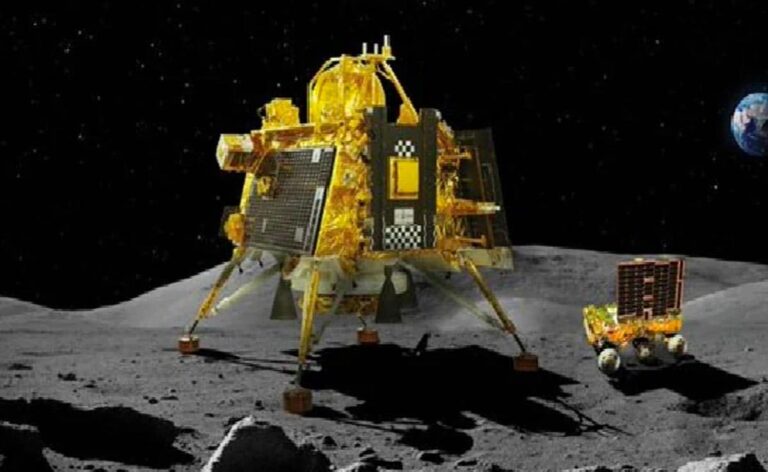India's Chandrayaan-3 Mission: A Step Closer to Understanding the Moon

Chandrayaan 3 scripts history with Vikram Lander’s smooth touchdown on the Moon’s south pole, positioning India as the first nation to grace this unexplored domain. The lander with a rover inside landed on the lunar surface at 6:04 am local time on August 23, 2023. Prime Minister Modi’s resounding declaration, “India will remember this day forever,” immortalizes the momentous occasion. Amidst a crescendo of applause, ISRO scientists celebrate, their brilliance shining as the world bears witness to this extraordinary feat. With the spacecraft’s successful landing, India not only solidifies its technological prowess but also unveils the lunar secrets that could unlock invaluable water and precious elements.
The Chandrayaan-3 mission consists of a lander named Vikram and a rover named Pragyan. The lander is about 1,500 kilograms and carries the rover, which is about 26 kilograms. The mission unfolds with a constellation of objectives: to delve into the mysteries of the lunar south pole – a haven potentially laden with water ice – and uncover the lunar landscape’s geological secrets. With its scientific toolkit in hand, the mission conducts experiments to decode the Moon’s enigmatic environment. A triumphant Chandrayaan-3 not only propelled the Indian Space Research Organisation (ISRO) into the upper echelons of space exploration but also cemented India’s place among the celestial pioneers. The mission is a follow-up to the Chandrayaan-2 mission, which was launched in 2019. Chandrayaan-2 successfully entered lunar orbit, but its lander Vikram crashed during the landing attempt.
Embarking on a celestial journey, Chandrayaan-3 sets its sights on unraveling the lunar enigma at the south pole, an intriguing region believed to harbor the treasures of water ice. The mission will also study the lunar surface and its geology, and conduct experiments to understand the Moon’s environment. The water ice on the Moon’s south pole is a valuable resource that could be used to support future human missions to the Moon. Additionally, the scientific data collected by the Chandrayaan-3 mission will help better understand the Moon and its potential as a resource for future exploration, including missions to bring samples of lunar soil back to Earth.
The challenges of landing on the Moon’s south pole
The Moon’s south pole is a challenging place to land a spacecraft. The terrain is uneven and there is a lot of dust, which makes it difficult for a spacecraft to land safely. The ISRO engineers have overcame these challenges by developing a new lander design that is more robust and maneuverable than the lander used in the Chandrayaan-2 mission. The new lander also has a more advanced landing radar that helped it to land safely on the Moon’s surface. ISRO has faced a number of challenges in developing the Chandrayaan-3 mission. Another difficulty was developing a rover that was small enough to fit inside the lander and that was capable of operating in the harsh conditions of the Moon’s south pole. Developing the communication system was another obstacle faced for the Chandrayaan-3 mission. The Moon’s south pole is a region where the communication links are weaker, so ISRO had to develop a new system that could overcome these challenges.
With one triumph paving the way for the next, ISRO’s journey continues to reach new heights. The head of ISRO announces the next mission – the much-anticipated “Aditya” mission scheduled for September. This will be India’s first mission to study the Sun. These milestones pave the way for the ultimate summit: Gaganyaan, India’s first voyage into manned space, which is set to redefine history by 2025.
